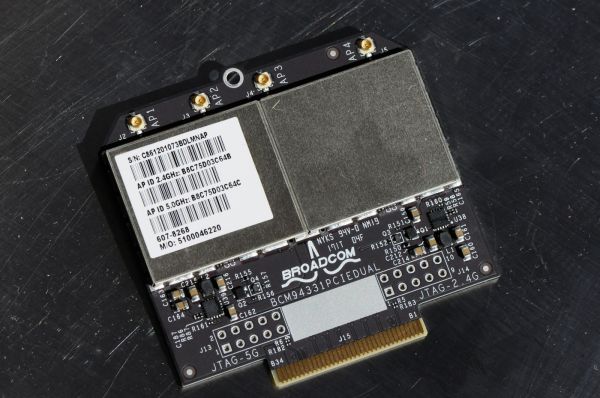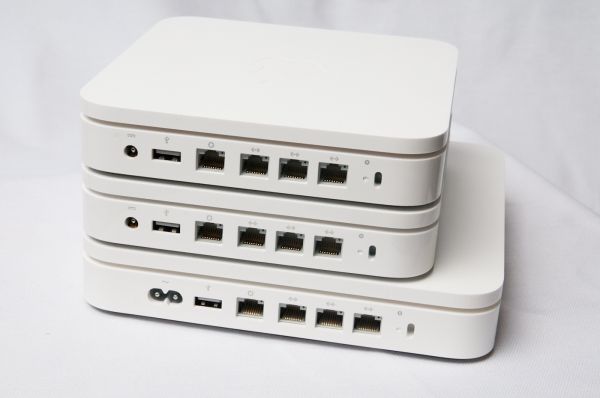Airport Extreme (5th Gen) and Time Capsule (4th Gen) Review - Faster WiFi
by Brian Klug on August 5, 2011 10:22 PM EST- Posted in
- Mac
- Airport Extreme
- Time Capsule
- WiFi
Conclusion and Final Thoughts
We’ve gone into extreme detail about the Time Capsule and Airport Extreme updates. I originally intended to have this posted with a hint of irony on WiFi day (8.02.11) but instead ended up spending that special day doing more testing and running even more instances of Iperf to make sure our numbers were solid. What’s changed between both previous generations is simple—the Time Capsule gets an official 3TB option, and both the Time Capsule and Airport Extreme now have a much more powerful, modern, and better-performing BCM4331 based WiFi stack.
The result of the move from Marvell to Broadcom is twofold. First, performance and range is definitely better thanks to more transmit power and the improved sensitivity afforded by newer generation chipsets. Second, the combination of lots of Broadcom in Apple’s hardware lineup (from the iPhone, iPad, and MacBooks, to iMac and Mac Mini) with Broadcom in the access point likely allows for the use of frame bursting or some other packet aggregation technique that speeds things up in some scenarios. It’s another example of how having that complete hardware control can in fact result in some benefit—in this case, faster WiFi.
Before this update, there were so many rumors about both iOS based Airport products, that the Time Capsule would cache software updates locally, and that the whole thing would somehow tie into Apple's iCloud solution. None of that exists right now, and it's looking like (for now) the rumor mill has some egg on its face. I waited patiently for Lion to launch and half expected things to turn on and render half of the review null; instead that day came and went without much change at all. As of this writing, the core functionality of the Airport line remains the same as it was before—sans any iCloud/iOS magic/local update caching.
There’s a stigma that Apple gear is more expensive, and for the 3TB Time Capsule that may be the case, but the Airport Extreme is actually right near where it should be. Take for comparison the Linksys E4200, which is a 2x3:2 device on 2.4GHz, and 3x3:3 on 5GHz, and also Broadcom based. That device runs for $179.99 and features similar functionality including a USB 2.0 port for sharing devices. At $179.00, the Airport Extreme offers full 3x3:3 on both 2.4 and 5GHz, albeit the E4200 does have considerably more Tx power, which we'll investigate in a forthcoming article.
I guess the reason that I personally use an Airport Extreme (in conjunction with another device for NAT) is that it's really one of a small number of 802.11n dual-band APs I've tried that actually works without locking up, becoming unstable periodically, dropping the session from overheating when being pushed to 100% for hours, or requiring a daily reboot. There are just so many other consumer level 802.11n APs that either fall short or are incredibly frustrating and unreliable. Thus far, I've been using an Airport Extreme Gen 5 and Time Capsule Gen 4 as my primary AP with over 12 devices attached to each one for the greater part of a month without a single instability. It's that kind of stability that really sells it for me, even with 3x3:3 out of the picture.
That kind of sums up WiFi in general—ideally, it should work and be something transparent to the user instead of a constant consideration. I wager the vast majority of Airport Extreme and Time Capsule owners have no idea what 3x3:3 is or how to even check their physical link rate, and for the most part that's a testament to how stable these devices are. Maybe that's the reason why Apple doesn't make a super huge note about changes like markedly improving their WLAN connectivity. One thing is for certain, Apple's wireless division is either playing it incredibly cool, or honestly not getting the credit it deserves.













90 Comments
View All Comments
Brian Klug - Sunday, August 7, 2011 - link
Yeah, I should note that right now idle seems to be around 8-9 watts without much change.-Brian
jalin2 - Monday, August 8, 2011 - link
I'm in the market to get a new router and was set on getting the E4200. Now I think I'm going to hold off and wait until your router comparison article. Any idea on timeframe when that'll be released?jackwong - Sunday, August 14, 2011 - link
I would rather go with Apple, the only good Linksys router I have is the WRT54. I also have the e2500 few months ago, I can't believe a 2011 router doesn't has gigabyte ports... and it has connection problem everyday...I would rather go with Apple Extreme base station unless the e4200 is way cheaper.
melgross - Monday, August 8, 2011 - link
I've had a lot of Linksys routers over the years, stupidly, because every one died. That includes some commercial models. I will NEVER use another Linksys product again.I've got one Extreme, and two Expresses, and have never had a problem with them. As the review says, they just work.
I've got an old house, built in 1925. Most interior walls are brick. All the walls and ceilings have .75" wood over the brick, with gal steel mesh over that, with .75" mortar, and a .25" layer of plaster over that. The damn thing is as close to a Faraday cage as anyone will ever live in. I've removed some of that when re-doing the kitchen and downstairs bathroom as well as the two bathrooms upstairs by having everything stripped to the beams and replaced with double .5" Sheetrock, but still...
Guspaz - Monday, August 8, 2011 - link
Perhaps some mention should be made of the fact that Apple advertises the drive in the Time Capsule as a "server-grade hard drive".You do mention that it's very much a consumer disk (in fact, the most "consumer" you can get since it's not even a black or RAID edition), but Apple is really billing the thing as server-grade, which is false advertising.
jwoelich - Monday, August 8, 2011 - link
"Fortunately, a source inside Western Digital was willing to explain matters; "If you enter in the drive number on NewEgg you're going to see it come up as a desktop drive. That platform is actually built on a lot of other products for a lot of different OEMs. And the specs could change depending on whatever program we're building for. Needless to say Apple has very stringent requirements that are very specific to them and very unique to them, and that drive has actually been developed and is unique for that Apple product. That unique Apple logo, and what we call 'to the right of the dash,' if you will, indicate that this drive is for a very particular partner to us and this drive is dedicated to that particular audience. You could not buy this same drive at NewEgg or Amazon."When we asked whether the variation of the WD20EARS drive is rated for a 1-million-hour MTBF, our source confirmed that it was: "We don't spec our desktop drives with MTBF because our customers don't purchase in that manner, but this particular drive for this particular OEM with these unique requirements does meet those specifications."
Western Digital says otherwise.
repoman27 - Monday, August 8, 2011 - link
lowlymarine did mention it in a comment two days ago, to which I pointed out that for price per GB and performance per watt the Caviar Green is tough to beat, and therefore perfect for servers. Just considering how many Google uses, I would be surprised if there is another line of drives more deployed in servers at the moment than Caviar Green.Not all "servers" are designed for crazy amounts of IOPS, massive queue depths, or incredibly high availability. For backup or redundancy, which is what the Time Capsule is marketed for, you want big, cheap and low-power.
No offense, jwoelich, but although the quote may be legitimate, I have a seriously hard time buying that line of utter crap. We're pretty much down to a three horse race in the storage arena, and just like Intel or AMD might bin things differently or cater to large OEMs in various ways, they basically just pump out a small range of identical products by the millions. There are no "magical drives" that are perfect for servers but not sold by Newegg. The way I read it, Apple had a very stringent range of specifications, to which a bog standard Caviar Green drive happens to adhere perfectly (i.e. low price per GB and low power requirements.)
jwoelich - Tuesday, August 9, 2011 - link
I don't see where anyone stated anything being 'magical', just that if you were to go onto Newegg, you couldn't just order one of these specific drives. Now, does that mean that there is more to it than Western Digital simply taking any WD Green drive, testing it to conform with the criteria set forth by Apple, then throw on a new sticker? Or did WD design/modify a product specifically to meet that criteria? More likely, WD crafted a Frankendrive using the criteria Apple set forth, and used the bare minimum of higher quality components that would more likely ensure that criteria was met, which was probably nothing more than power consumption, size, speed and a greater MTBF.LoneWolf15 - Monday, August 8, 2011 - link
"Some more searching revealed the solution—pin 20 (wireless disable) needs to be taped over to signal the card that the wireless disable switch (which doesn’t exist, since this is the WAN port) is in the on position. A quick surgical application of tape, and the card worked perfectly—take that, Lenovo security. As an aside, what a completely pointless and trivial barrier this is—the Mini PCIe standard (and moreover WiFi notebook cards themselves with U.FL connectors) are designed to be completely and absolutely interchangeable. The notion that this provides any added security (when the adjacent slot is completely unguarded) or—even more absurd, convenience—is nothing short of a surrealist notion."Lenovo isn't the only one. HP also does the exact same thing; they whitelist cards in the BIOS, so that only their branded version of Intel's (or Broadcom's) wireless cards work.
I don't think security has anything to do with it. I think two factors are involved --1) that they don't want to support any other wireless cards than their own, and 2) that they want you to buy from them, establishing vendor lock-in.
Dug - Monday, August 8, 2011 - link
There are also modified BIOS' out there that disable the whitelist which is a lot easier than trying to tape a small pin.If the laptop has a 2nd pci slot, which is usually reserved for wlan card, you can use this for the wireless card becuase the BIOS doesn't look at that slot.